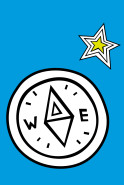

In the process of earning the Intellectual Property Patch, Scouts will:
Below is the process of earning the Intellectual Property Patch.
Learn about the types of intellectual property (IP), how each type is protected (with patents, trademarks, copyrights, or trade secrets), and why protecting IP is important for creators.
Be able to identify examples of things protected by the various forms of IP protection: patents, trademarks, copyrights, and trade secrets.
Demonstrate knowledge of what a patent is by identifying the basic parts of a patent and using an existing expired patent as a basis for recreating an invention. One example frequently used is the recreation of Girl Scout founder Juliette Gordon Low's patent for a recyclable trash can liner, U.S. Patent No. 1,124,925.
(In addition to the utility patent for the recyclable trash can liner, did you know that Juliette Gordon Low also owned a design patent for the Girl Scouts trefoil badge? More than a century later, the Girl Scouts organization still uses the design as a trademark for badges, pins, logos, and—most deliciously—the shape of the shortbread cookies called Trefoils, on sale every spring.)
Explore the concept of innovation by modifying, adapting, or improving an existing invention, or by developing a new invention of their own.
Draft a mock patent application to include some of the basic information found in a patent application.
Demonstrate knowledge of the role and function of a trademark by creating their own trademark.
Demonstrate knowledge of the types of matter that can be protected by copyright and develop their own "original work of authorship."
Students at some levels of the patch are expected to develop the skills to conduct basic searches for patents and trademarks utilizing the USPTO databases and publicly available resource and research tools. Students can also explore copyrights by creating their own creative works and exploring the benefits of registering works with the U.S. Copyright Office. Real-world examples of girls and women who have received U.S. patents, registered trademarks, or registered copyrights are provided as examples to demonstrate the potential of girls to invent, create, and go into business as well as the accessibility and value of IP protection. Students are all encouraged to explore careers in intellectual property; science, technology, engineering, and mathematics (STEM); the arts; and computer science.
FAQs

What is the Intellectual Property Patch?
The original Intellectual Property (IP) Patch was developed as a joint project between the Girl Scout Council of the Nation's Capital (GSCNC) and the USPTO, and in collaboration with the Intellectual Property Owners (IPO) Education Foundation.
The USPTO and GSCNC collaborated on the development of an IP Patch program to help more students become aware and knowledgeable of intellectual property. The program includes supporting guides and sample activities for girls of all ages, designed to increase awareness of and interest in the creation and protection of intellectual property (IP) across disciplines and particularly as it relates to the fields of science, technology, engineering, and mathematics (STEM).

Is the patch open to all levels of the Girl Scouts?
The patch is available in four levels (Brownie, Junior, Cadette, and Senior). Daisies have also completed patch activities and girls have utilized patch activities to earn their Silver and Gold awards.
The Girl Scout Brownie level of the IP Patch (“Imagination Pioneer”) introduces girls to the tools that allow inventors to benefit from their inventions while also sharing them with others.
In the Girl Scout Junior level of the IP Patch (“Inventive Products”), girls learn about basic concepts of intellectual property protection and how various forms of intellectual property protection such as patents can allow inventors to protect their inventions while inspiring others to improve upon existing art or technology and invent something of their own.
The Girl Scout Cadette level of the IP Patch (“Investigating Possibilities”) teaches girls how to add value to their business by using intellectual property to enhance their business and to promote and protect their work.
The Girl Scout Senior level of the IP Patch (“Inspiration Producers”) shows Scouts how intellectual property can be used to help protect and promote innovation.

Is the IP Patch available to all scouts?
Yes. While the patch was developed locally with the Girl Scout Council of the Nation's Capital, the program is open to students across the U.S.
Examples include patch programs in Texas, Colorado, and numerous other grassroots efforts with Councils or through IP organizations such as Intellectual Property Owners Education Foundation (IPOEF), the CHiPS Network, and private law firms.
Have any scouts in your troop earned the IP Patch? We’d love to hear from you and share your journey here – email us at education@USPTO.gov.
Girl Scout Council of the Nation's Capitol
GSCNC is one of the largest and most diverse Girl Scout Councils in the country, with more than 76,000 members that include more than 46,000 members in grades K-12 from the District of Columbia and 25 counties in Maryland, Virginia, and West Virginia.
IPO Education Foundation
IPO Education Foundation is a non-profit organization devoted to promoting intellectual property education and awareness.
Don't miss out
See more of our activities and ways to learn about IP!

Inventor Trading Cards

Explore intellectual property (IP)







